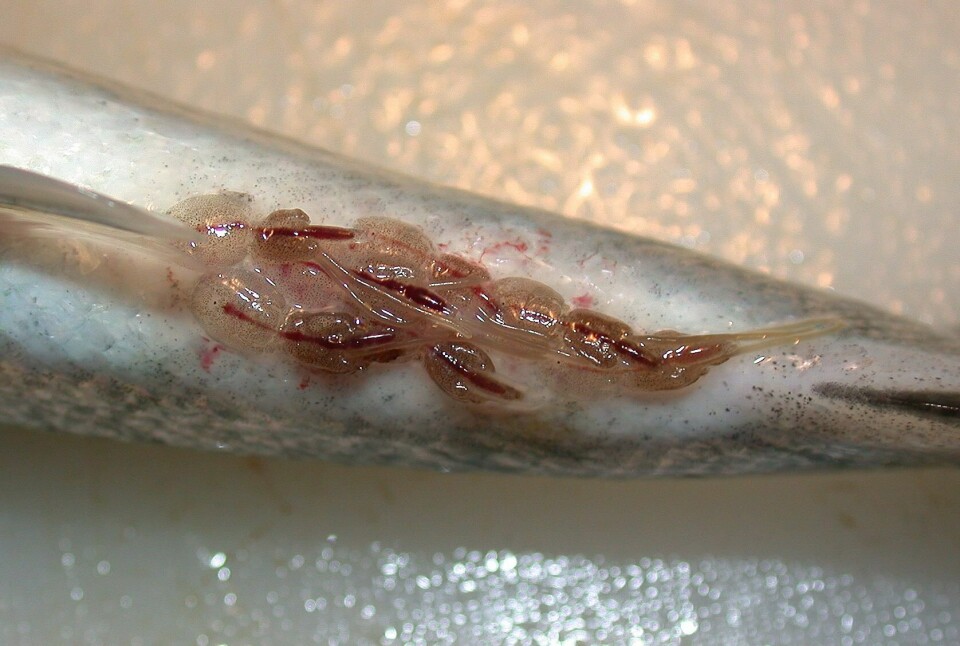
Fish farming may help evolution of super louse
Emerging research suggests that parasites and diseases of farmed fish may be evolving to become even more harmful.
Mathias Stølen Ugelvik at the University of Bergen, Norway, and colleagues found that Atlantic salmon (Salmo salar) infected with salmon lice (Lepeophtheirus salmonis) derived from two Norwegian fish farms suffered more-severe symptoms than those infected with lice from wild salmon, The Scientist website reports.
“Salmon lice from areas with fish farming appear to have evolved toward a higher virulence as compared to salmon lice from other areas,” study co-author Arne Skorping of Bergen wrote in an email. The team’s findings were published in the Journal of Evolutionary Biology this month (April 4).

Skorping and colleagues collected lice eggs from farmed and wild-caught salmon, then reared the lice under identical conditions for three generations to ensure any differences between them were genetic. The researchers then infected 55 adult salmon with the descendants of farm or wild-caught lice, finding that farm-derived lice caused significantly larger skin lesions and greater weight loss to their hosts.
Anthropogenic effects
The Scientist quoted Vicki Blazer, who studies fish health at the US Geological Survey’s Leetown Science Center in West Virginia, and was not involved in the study which she said “begins to look at a possibly very important factor in fish health—the change in virulence of parasites and other pathogens due to anthropogenic effects.” However, she noted, the experiment was limited by its small sample size and a lack of information about the fish and lice collection sites.
The very characteristics that make aquaculture so productive may also favour the evolution of greater virulence, says the website’s article. According to some ecologists, fish farming may have unintentionally created a global experiment on pathogen evolution.
“The environment of intensive culture - stressed, genetically homogenous animals packed in high density conditions - is practically a recipe for cultivating highly virulent parasites,” Tommy Leung from the University of New England, who was not involved in the study, wrote in an email.
High-density conditions
High-density conditions aid disease transmission and may inadvertently select for salmon lice that spread rapidly and cause their hosts greater harm. In a 2012 study, Skorping and colleagues found a positive correlation between L. salmonis transmission rates and virulence. The team’s latest findings add “empirical evidence that salmon lice from aquaculture environments are indeed more harmful towards their host,” Leung wrote. “Intensive farming places different selection pressures on pathogens and parasites to what they are confronted with in the wild . . . and this will affect their evolutionary trajectory.”
The problem is not confined to lice. In a study published in Proceedings of the Royal Society B last year, researchers at the University of Jyväskylä in Finland reported signs of increasing virulence in the fish pathogen Flavobacterium columnare over time. Lotta-Riina Sundberg of Jyväskylä and colleagues collected samples of these bacteria from three Finnish fish farms between 2003 and 2010, and from sites upstream and downstream of one farm in 2010.
“Making host-to-host transmission as difficult as possible will give fewer chances for natural selection to act in favour of virulence,” Sundberg told The Scientist. This might be achieved through lower stocking densities, more effective separation of wild from farmed fish, or recovery periods for farmed waters. “In the longer term, aquaculture needs to rely more on evolutionary science to achieve sustainability,” Skorping noted.























































